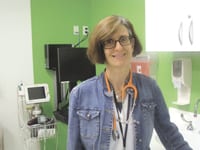Dose of Reality Hospitals Implement Changes to Reduce Fatal Medication Errors
The numbers have been reported countless times since a 1999 Institute of Medicine report claimed that at least 44,000 deaths annually are caused by medical errors in hospitals, and at least 7,000 of them are related to medications.
But raw numbers can become numbing after a time. Putting a face on the statistics — or three faces — carries a little more power.
That’s what happened last fall in Indianapolis, when three premature infants died at Methodist Hospital after being given an adult-sized dose of heparin, a common blood-thinning agent that’s used to prevent clots that could clog intravenous tubes.
In all, six infants were given the wrong dose of the drug, which a pharmacy technician had accidentally stored in the drug cabinet of the neonatal intensive care unit. And the incident wasn’t the hospital’s first of its kind. In 2001, two patients in the pediatric intensive care unit were given a similar overdose of heparin; both recovered.
“We all feel very deep sorrow,” Deb Hutchins, a neonatal nurse practitioner, told a reporter after last year’s incident. “It’s just going to be a very long healing process for all of us.”
As it turns out, it was also the beginning of a long process of reassessing how drugs are administered at Methodist Hospital. But such discussions didn’t stop at that facility’s front doors. They have triggered a national wave of quiet changes by hospitals that do not want to repeat the fatal error.
A Closer Look
Gary Kerr, director of Pharmacy Services at Baystate Medical Center, said his hospital used the Indianapolis tragedy as an opportunity to re-examine its own system of administering medicine to patients, starting with the way it handles heparin.
“We went around the whole hospital, starting with the Children’s Hospital, and examined our processes, storage, and ordering to make sure nothing like that happens here,” he said. For one thing, they noted that not only did someone at Methodist Hospital put the wrong vial in the NICU cabinet, but the nurse who administered it didn’t pay close attention to the label. “So even though there was a storage issue, there was a human element too,” Kerr said.
Baystate does not stock heparin in a NICU cabinet and no longer orders the higher doses, but that’s no reason to be complacent, he said. In addition, the hospital has identified certain high-risk “drugs of concern” and uses a new, fluorescent label to identify them. In addition, pharmacy technicians are required to visually check all vial strengths before releasing them, and two nurses are required to check the vial before administering the drug.
Besides heparin, oncology medications have also been targeted as drugs of concern. “No cancer drug leaves the pharmacy without two different people reading and transcribing the order,” Kerr said.
The Indianapolis story was a wake-up call, said Mark Heelon, medication safety specialist at Baystate. “The morning after this tragedy occurred, Gary called me into his office,” he said. “We wanted to find out what we were doing and come up with ways to improve patient safety.”
In truth, all hospitals have dealt with the medication-error issue in one way or another; since the 1999 report, various agencies have issued a very public call to hospitals to examine their own drug-administration policies and make changes where possible to save lives.
And no wonder: in a study by the U.S. Food and Drug Administration (FDA) that evaluated reports of fatal medication errors between 1993 and 1998, the most common error involving medications was an improper dose of medicine, accounting for 41{06cf2b9696b159f874511d23dbc893eb1ac83014175ed30550cfff22781411e5} of deaths. Meanwhile, giving the wrong drug and using the wrong route of administration each accounted for 16{06cf2b9696b159f874511d23dbc893eb1ac83014175ed30550cfff22781411e5} of the errors.
Multi-layered Approach
Holyoke Hospital, like Baystate, has put layers of protection in place when dealing with certain medications, said Dawn Chartier, clinical improvement manager.
“One of our high-risk medications is insulin,” which is stored in a locked system, she explained. “In order for a nurse to retrieve it, she needs to have somebody double-check the dose and cosign for it.” Anti-coagulation medications such as heparin and Coumadin get similar attention.
“You can approach this in so many ways. We’ll soon go live with electronic medical administration records, which will improve the accuracy of medication dispensing,” Chartier said. She explained that, with a paper system, patient medication information is written in boxes, and when those boxes are filled, the patient’s information is rewritten on another sheet. “Every time you have to rewrite something, you have the potential for errors. That’s why computer-assisted physician order entry is also on our horizon.”
Other safety steps are decidedly low-tech, she added. For instance, employees administering medications in house must first identify the patient by both name and birth date. And to make sure the staff works in close proximity to patients, the hospital has set up pod-like nursing stations in the unit hallways — a departure from the old system of large, centralized stations.
“With nurses so close, they’re only traveling 10 feet or so to the patient, which reduces the distractions and interruptions, as opposed to going down entire hallways,” Chartier said.
Then there’s the issue of IV pumps. Michelle Meadows, a marketing official with the FDA, tells the story of Jacquelyn Ley, a 9-year-old Minnesota resident who shattered her elbow on the soccer field. After a successful surgery at a Minneapolis hospital, she received morphine through a pump. Her mother stayed overnight with her, and when she checked on Jacqueline in the middle of the night, she found her barely breathing, and called for help.
“The morphine pump hadn’t been shut down, but had accidentally been turned up high,” Meadows reported. “The narcotic flooded Jacquelyn’s body. She survived the overdose, but it was a close call.”
Such stories aren’t unheard of, which is why Holyoke Medical Center has started using what are colloquially referred to as “smart pumps.”
“Each pump has a programmed profile, which includes the medicines that are OK for use on that floor, and the approved doses,” Chartier said. “If a high dose is accidentally put in — say someone presses 100 ccs when it’s supposed to be 10 — the machine captures that and asks them if that’s really what they want to do.”
Check It Out
The stories Meadows writes about, culled from all over the U.S., can give anyone pause, because the errors they describe are so easy to make. For example, one physician ordered a 260 mg dose of Taxol for a patient, but the pharmacist prepared 260 mg of Taxotere instead; the patient died. Another died because 20 units of insulin were abbreviated as “20 U,” the U was mistaken for a zero, and 200 units were injected. Yet another patient developed a fatal hemorrhage when given another patient’s prescription for Coumadin.
To eliminate many of these human errors, the FDA has been pushing for a bar-code technology in hospitals, by which caregivers would use scanning equipment to read bar codes on both the drug and a wristband worn by the patient. Baystate is one of the hospitals working toward implementing such a system. But Kerr said other pieces need to fall into place as well — specifically, hospitals, pharmacies, and wholesalers must get on the same page in labeling drugs.
Still, “if they can do it at Big Y, why not at pharmacies?” he asked. “We do take this issue seriously. We don’t want what happened in Indianapolis to happen here.”
Chartier said the safety issue is far more important than people’s feelings, which is why HMC has no blame culture for reporting errors, which ensures that incidents are quickly reported. “We’re not looking at the individual nurse problem, but at what error in the system allowed a mistake to happen,” she said.
“We also post all data on bulletin boards in each unit,” she continued, “and we keep staff aware of how their unit is doing with all data points, which include medical errors, fall rates, and length of stay.
“This is the work of a lot of groups pulling together and hitting it from all ends,” she said.
That should provide some comfort to patients, for whom medication errors are more than a statistic. Just ask three families in Indiana.




Comments are closed.